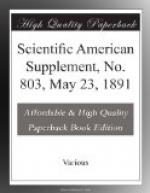w v P = ------ - 1.5 d squared 400
[TEX: P = \frac{w \ v}{d^2 \ 400} — 1.5]
for plates more than two and one-half inches thick.
If [theta] be the angle between the path of the projectile and the face of the plate, then v in the above formulae becomes v sin [theta].
When we come to back the plates, their power to resist penetration becomes greater, and our formula changes. The Gavre formula, given above, is used to determine the velocity necessary for a projectile to pass entirely through an iron plate and its wood backing.
Compound and steel armor are said to give about 29 per cent. more resisting power than wrought iron, but in one experiment at the proving ground, at Annapolis, a compound plate gave over 50 per cent. more resisting power than wrought iron.
The Italian government, after most expensive and elaborate comparative tests, has decided in favor of the Creusot or Schneider all-steel plates, and has established a plant for their manufacture at Terni, near Rome.
The French use both steel and compound plates; the Russians, compound; the Germans, compound; the Swedes and Danes use both. Spain has adopted and accepted the Creusot plate for its new formidable armored vessel, the Pelayo; and China too has recently become a purchaser of Creusot plates.
Certain general rules may be laid down for attacking armor. If the armor is iron, it is useless to attack with projectiles having less than 1,000 feet striking velocity for each caliber in thickness of plate. It is unadvisable to fire steel or chilled iron filled shells at thick armor, unless a normal hit can be made. When perforation is to be attempted, steel-forged armor-piercing shells, unfilled, should be used. They may be filled if the guns are of great power as compared to the armor. Steel and compound armor are not likely to be pierced by a single blow, but continued hammering may break up the plate, and that with comparatively low-powered guns.
Wrought iron must be perforated, and hard armor, compound or steel, must be broken up. Against wrought iron plates the projectile may be made of chilled cast iron, but hard armor exacts for its penetration or destruction the use of steel, forged and tempered. Against unarmored ships, and against unarmored portions of ironclads, the value of rapid-firing guns, especially those of large caliber, can hardly be overestimated.
The relative value of steel and compound armor is much debated, and at present the rivalry is great, but the weight of evidence and opinion seems to favor the all-steel plate. The hard face of a compound plate is supposed to break up the projectile, that is, make the projectile expend its energy on itself rather than upon the plate, and the backing of wrought iron is, by its greater ductility, to prevent the destruction of the plate. It seems probable that these two systems will approach each other as the development goes on. An alloy of nickel and steel is now attracting attention and bids fair to give very good results.




